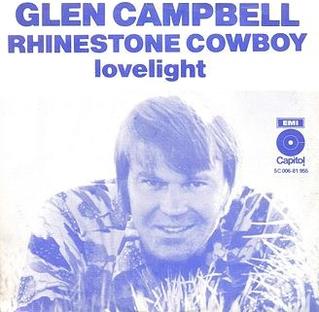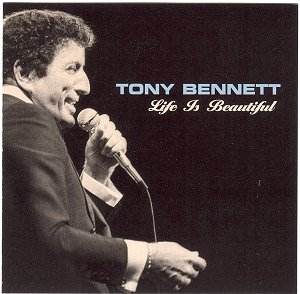Related Research Articles

Anthony Dominick Benedetto, known professionally as Tony Bennett, was an American jazz and traditional pop singer. He received many accolades, including 20 Grammy Awards, a Lifetime Achievement Award, and two Primetime Emmy Awards. Bennett was named a National Endowments for the Arts Jazz Master and a Kennedy Center Honoree. He founded the Frank Sinatra School of the Arts in Astoria, Queens, New York, along with Exploring the Arts, a non-profit arts education program. He sold more than 50 million records worldwide and earned a star on the Hollywood Walk of Fame.
John Alfred Mandel was an American composer and arranger of popular songs, film music and jazz. The musicians he worked with include Count Basie, Frank Sinatra, Peggy Lee, Anita O'Day, Barbra Streisand, Tony Bennett, Diane Schuur and Shirley Horn. He won five Grammy Awards, from 17 nominations; his first nomination was for his debut film score for the multi-nominated 1958 film I Want to Live!

"Night and Day" is a popular song by Cole Porter that was written for the 1932 musical Gay Divorce. It is perhaps Porter's most popular contribution to the Great American Songbook and has been recorded by dozens of musicians. NPR says "within three months of the show's opening, more than 30 artists had recorded the song."
"In the Cool, Cool, Cool of the Evening" is a popular song with music by Hoagy Carmichael (1899-1981), and lyrics by Johnny Mercer (1909-1976). It was originally planned to feature it in a Paramount Pictures film written for Betty Hutton (1921-2007), that never took off, which was to be called The Mack Sennett Girl. The song was buried in Paramount's files until it was rediscovered and then used in the 1951 film Here Comes the Groom and won the Academy Award for Best Original Song.

"One for My Baby (and One More for the Road)" is a song written by Harold Arlen and Johnny Mercer for the movie musical The Sky's the Limit (1943) and first performed in the film by Fred Astaire.
George Warren Barnes was an American swing jazz guitarist. He was also a conductor, composer, arranger, producer, author, and educator. He was hired by the NBC Orchestra at the age of 17, making him the youngest musician on staff. At 17, he was considered to be a great player by many musicians, including Tommy Dorsey, and Jimmy McPartland. Barnes was also proficient as a recording engineer. During his career, Barnes recorded with singers Mel Tormé, Ella Fitzgerald, Frank Sinatra, Bing Crosby, Patti Page, Dinah Washington, Lena Horne, Billy Eckstine and Johnny Mathis among many others. He was an inspiration to, and influenced guitarists Chet Atkins, Roy Clark, Herb Ellis and Merle Travis, among many others.

"Rhinestone Cowboy" is a song written and recorded by Larry Weiss in 1974, then popularized the next year by American country music singer Glen Campbell. When released on May 26, 1975, as the lead single and title track from his album Rhinestone Cowboy, it enjoyed huge popularity with both country and pop audiences.
"Dancing in the Dark" is a popular American song, with music by Arthur Schwartz and lyrics by Howard Dietz, that was introduced by John Barker with Tilly Losch dancing in the 1931 revue The Band Wagon. The song was first recorded by Bing Crosby on August 19, 1931 with Studio Orchestra directed by Victor Young, staying on the pop charts for six weeks, peaking at #3, and helping to make it a lasting standard.
"Young and Foolish" is a popular song with music by Albert Hague and lyrics by Arnold B. Horwitt, published in 1954.

"Fascinating Rhythm" is a popular song written by George Gershwin in 1924 with lyrics by Ira Gershwin.
"Steppin' Out with My Baby" is a popular song written by Irving Berlin and introduced in the 1948 musical film Easter Parade. There it was sung by Fred Astaire as part of a dance number involving Astaire on stairs and three different dance partners.
"I Won't Dance" is a song with music by Jerome Kern that has become a jazz standard. The song has two different sets of lyrics: the first written by Oscar Hammerstein II and Otto Harbach in 1934, and second written by Dorothy Fields in 1935.
"Top Hat, White Tie and Tails" is a popular song written by Irving Berlin for the 1935 film Top Hat, where it was introduced by Fred Astaire.
"I Used to Be Color Blind" is a popular song written by Irving Berlin for the 1938 film Carefree, where it was introduced by Fred Astaire. The Astaire recording was very popular in 1938.
"Isn't This a Lovely Day?" is a popular song written by Irving Berlin for the 1935 film Top Hat, where it was introduced by Fred Astaire in the scene where his and Ginger Rogers' characters are caught in a gazebo during a rainstorm. The lyric is an example of a song which turns a bad situation into a love song, a common style for Irving Berlin, as in "I've Got My Love to Keep Me Warm" and "Let's Have Another Cup of Coffee".
"Dream Dancing" is a song written by Cole Porter for the 1941 film You'll Never Get Rich, where it was introduced as an instrumental. The first recording was made by Fred Astaire with Harry Sosnik and his Orchestra and The Delta Rhythm Boys in 1941 under the Decca label (#18188).
"I Guess I'll Have to Change My Plan" is a popular song published in 1929, with music by Arthur Schwartz and lyrics by Howard Dietz.

Life Is Beautiful is an album released by Tony Bennett in 1975. It was named after the song written by Fred Astaire. The album was the first project of Bennett's own Improv label. The album was Bennett's tribute to the American songbook featuring songs of Cole Porter, Richard Rodgers, Irving Berlin and others. The pianist, Torrie Zito, wrote new arrangements for Bennett's large session orchestra. The album was reissued by Concord with the addition of a separately recorded 13-minute Cole Porter medley.
"While We're Young" is a 1943 song with music composed by Alec Wilder and Morty Palitz, to lyrics by Bill Engvick, which was popularized by Don Cherry, Tony Bennett and other artists. Wilder quoted his Algonquin neighbour, James Thurber, as saying that Engvick's lyrics to "While We're Young" was "the finest piece of English writing he knew". The lyric Thurber refers to begins:
We must fulfill This golden time When hearts awake So shyly, Softly.
Songs were made to sing While we're young. Ev'ry day is spring While we're young...
Duncan Lamont was a saxophonist, composer and bandleader active for many years in London's Soho jazz scene. His soundtracks include the music to the 1970s children's television animation series Mr Benn.
References
- ↑ "Discogs.com". Discogs.com. Retrieved June 7, 2020.
- ↑ Evanier, David (2011). All the Things You Are: The Life of Tony Bennett . p. 227. ISBN 9780470520659.
- ↑ Hemming, Roy (1992). Hajdu, David (ed.). Discovering Great Singers of Classic Pop . Newmarket Press. p. 75. ISBN 1557041482.
- ↑ Leamer, Laurence (2005). King of the Night: The Life of Johnny Carson . HarperCollins. p. 7. ISBN 0060840994.